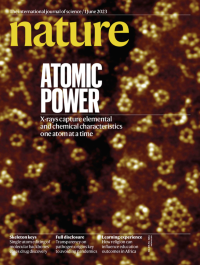Volume 618
-
No. 7967 29 June 2023
Shining exampleRNA molecules can adopt complex 3D structures, but whether DNA can self-assemble into similar 3D folded structures has been less clear. In this week’s issue, Luiz Passalacqua and his colleagues use a DNA mimic of green fluorescent protein (GFP) to investigate this question. Called Lettuce, the mimic can induce fluorescence in a number of fluorophores. The researchers used X-ray crystallography and cryogenic electron microscopy to characterize complexes of Lettuce with several fluorophores. They found that Lettuce folds in an unusual way to connect with a fluorophore and induce fluorescence, suggesting that DNA can self-assemble into complex 3D structures, and shedding light on how the structural organization of DNA helps confer biochemical function. A Lettuce–fluorophore complex is depicted on the cover (centre) along with GFP (top) and an RNA aptamer with a similar function called Spinach (bottom right).
Nature Outlook
-
No. 7966 22 June 2023
Molecular repellentSpringtails (Collembola), such as Tetrodontophora bielanensis shown on the cover, are invertebrates that respire through their skin and so need to keep that surface free from contamination. In this week’s issue, Carsten Werner and his colleagues reveal how layers of cholesterol give springtails their non-stick coating. Using a combination of experiments and atom-level simulations, the researchers found that the repulsive ability of cholesterol layers arises from fluctuations in the orientation of the cholesterol molecules. These fluctuations give rise to ‘entropic repulsion’ — essentially, adsorption of biomolecules onto the skin would require the cholesterol molecules to be constrained, which would lower the entropy and so is thermodynamically less favourable. The team suggests this insight could help the design of materials that limit adhesion.
-
No. 7965 15 June 2023
Cutting through the noiseThe cover depicts a quantum circuit, representing quantum computing being brought into focus by error mitigation. Quantum computers promise to be substantially faster than their classical counterparts at solving certain problems. But unavoidable environmental noise causes errors in quantum machines, and fixing these errors faster than they accumulate is beyond existing quantum processors. In this week’s issue, Abhinav Kandala and his colleagues show that it is still possible for a quantum computer to outperform a classical computer, by mitigating, rather than correcting, the errors. The researchers used an IBM processor composed of 127 qubits on a chip to generate large, entangled states that simulate the dynamics of spins in a model quantum material and accurately predict properties such as its magnetization. The team also shows that leading classical approximations struggle to produce these results. The researchers suggest that with error mitigation, existing and near-future quantum computers might be good enough to help with problems that are beyond the reach of classical machines.
Spotlight
-
No. 7964 8 June 2023
Growth factorCoral reef fishes, such as the blenny Ecsenius stictus pictured on the cover, are diverse, abundant and grow quickly. In this week’s issue, Alexandre Siqueira and his colleagues investigate the evolutionary history of these fishes to find out how growth has shaped life on coral reefs. The researchers looked at a wide variety of species and found that evolutionary shifts nearly always gave rise to faster growth, and that these shifts occurred across the Eocene epoch some 60 million to 40 million years ago, when global temperatures were quite hot. The results suggest that warmer sea temperatures might have led to the evolution of small, fast-growing fishes, with the subsequent development of coral reefs supporting their retention.
Nature Outlook
-
No. 7963 1 June 2023
Atomic powerX-rays are widely used to characterize materials, but samples still require a reasonably high number of atoms for success. In this week’s issue, Saw-Wai Hla and his colleagues report that they have used synchrotron X-rays to characterize the elemental and chemical state of an individual atom. The team was able to detect X-ray-excited currents generated from an iron and a terbium atom in molecular hosts. The ring-shaped supramolecules containing iron are pictured on the cover: these feature terpyridine subunits linked together by seven metal-atom bridges, six of which are ruthenium, only one of which is iron. The researchers were able to characterize the iron atom when the detector tip was around 0.5 nanometres directly above the atom.





